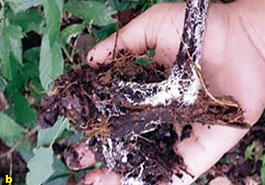Mountain microorganisms: an essential tool in the regeneration of agricultural soils
Abstract
Mountain microorganisms are several dozen functional groups of bacteria, actinomycetes, fungi, algae and protozoa that inhabit moist forest mulch, in perfect harmony, to keep alive the miracle and the energetic flow of life in each space and fraction of weather. Mountain microorganisms are genetically conditioned to produce soil, this is because for centuries, they have been working in forests and jungles, as well as in savannas and grasslands, forming soil, either decomposing organic matter or forming humic-clay aggregates. In addition, they help to maintain the balance of the forest and the rhizosphere, preventing diseases (Photo 1).
Each microorganism has registered in its memory, the genetic history of the place and distance where they could establish their evolution, development, reproduction, decomposition and death. Likewise, with the seed of the native microorganisms of a forest, we re-found the life that has been destroyed in cultivated lands and we nurture the hope of approaching the reconstruction of a tissue that is biologically indivisible and essential for a healthy life.
In the same way, with respect to agricultural soils, we can see that most of them are heavily contaminated with agrochemical residues. Mountain microorganisms have the ability to break down the molecules of these chemicals and decontaminate soils. There are different methodologies that will allow us to reproduce and use them in our crops to obtain the indicated benefits. One of the ways is applying them to the soil in the following way: 50% before planting and afterwards, depending on the crop. In the case of fruit trees, it is recommended to apply them at 20%, once a month and for vegetables, foliar applications at 10%, once a week. (Photos 2 and 3). It is very important to maintain a good level of organic matter in the soil, so that these microorganisms reproduce more and more.
References
Primavesi, A. 2003. Los bioindicadores del suelo. Una herramienta de análisis en la agricultura orgánica. Fundación universitaria juan de Castellanos. Seminario-taller. Tunja, Colombia. 56 p.
Primavesi, A. 1981. Manejo ecológico do solo, Sao Paulo, Brasil. 541p.
Restrepo, J. 2013. El A,B,C de la agricultura orgánica, fosfi tos y panes de piedras. 1era edición. Santiago de Cali. 396 p. Simón, J. 2016. Manual de macrobiótica en la remineralización de suelos en manos campesinas. Guadalajara. México. 93 p.


